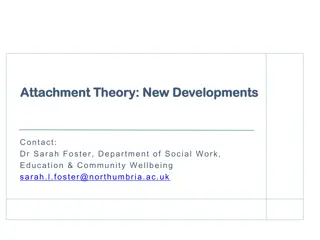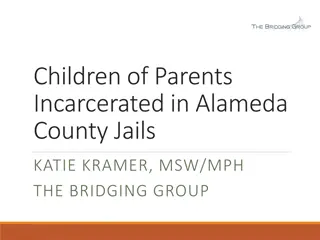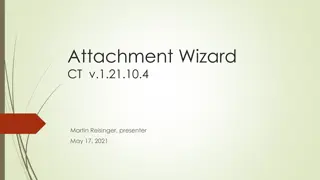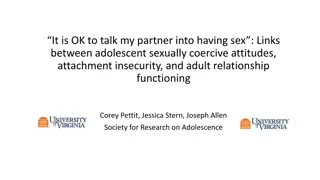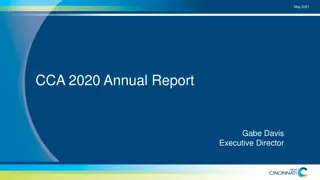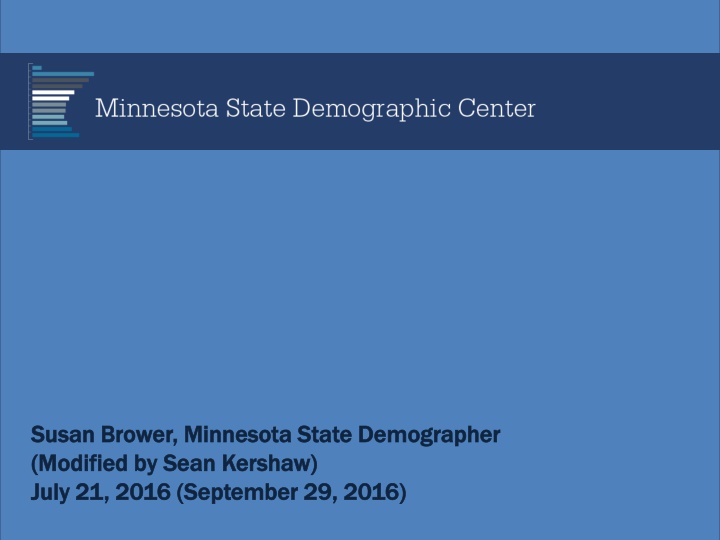
Minnesota State Demographic Trends: Aging Population Insights
Explore Minnesota's changing demographic landscape with a focus on the increasing number of older adults over the next two decades. Visual data from the Minnesota State Demographic Center highlights past and projected population shifts by age and sex, providing valuable insights into the state's future composition.
Download Presentation

Please find below an Image/Link to download the presentation.
The content on the website is provided AS IS for your information and personal use only. It may not be sold, licensed, or shared on other websites without obtaining consent from the author. If you encounter any issues during the download, it is possible that the publisher has removed the file from their server.
You are allowed to download the files provided on this website for personal or commercial use, subject to the condition that they are used lawfully. All files are the property of their respective owners.
The content on the website is provided AS IS for your information and personal use only. It may not be sold, licensed, or shared on other websites without obtaining consent from the author.
E N D
Presentation Transcript
Susan Brower, Minnesota State Demographer Susan Brower, Minnesota State Demographer (Modified by Sean Kershaw) (Modified by Sean Kershaw) July 21, 2016 (September 29, 2016) July 21, 2016 (September 29, 2016)
NUMBER OF MNS OLDER ADULTS WILL INCREASE SUBSTANTIALLY OVER THE NEXT 20 YEARS Change in older adults, age 65+ (Thousands) Change in older adults, age 65+ (Thousands) 91 85 71 67 55 47 - - - - - 1950s 60s 70s 80s 90s 00s 10s 20s 30s 40s 2050s Sources: U.S. Census Bureau and Minnesota State Demographic Center
NUMBER OF MNS OLDER ADULTS WILL INCREASE SUBSTANTIALLY OVER THE NEXT 20 YEARS Change in older adults, age 65+ (Thousands) Change in older adults, age 65+ (Thousands) 335 285 97 91 85 71 67 66 56 55 47 1950s 60s 70s 80s 90s 00s 10s 20s 30s 40s 2050s Sources: U.S. Census Bureau and Minnesota State Demographic Center
WHAT MINNESOTA LOOKED LIKE LAST YEAR Population by age and sex Minnesota, 2015 85 years and over 80 to 84 years 75 to 79 years 65 years 70 to 74 years 65 to 69 years 60 to 64 years 55 to 59 years 50 to 54 years 45 to 49 years Female 40 to 44 years Male 35 to 39 years 30 to 34 years 25 to 29 years 20 to 24 years 15 to 19 years 10 to 14 years 5 to 9 years Under 5 years 250000 200000 150000 100000 50000 0 50000 100000 150000 200000 250000 Source: Minnesota State Demographic Center
WHAT MINNESOTA WILL LOOK LIKE IN 9 YEARS Population by age and sex Minnesota, 2025 85 years and over 80 to 84 years 75 to 79 years 70 to 74 years 65 to 69 years 60 to 64 years 55 to 59 years 50 to 54 years 45 to 49 years Female 40 to 44 years Male 35 to 39 years 30 to 34 years 25 to 29 years 20 to 24 years 15 to 19 years 10 to 14 years 5 to 9 years Under 5 years 250000 200000 150000 100000 50000 0 50000 100000 150000 200000 250000 Source: Minnesota State Demographic Center
WHAT MINNESOTA WILL LOOK LIKE IN 19 YEARS Population by age and sex Minnesota, 2035 85 years and over 80 to 84 years 75 to 79 years 70 to 74 years 65 to 69 years 60 to 64 years 55 to 59 years 50 to 54 years 45 to 49 years Female 40 to 44 years Male 35 to 39 years 30 to 34 years 25 to 29 years 20 to 24 years 15 to 19 years 10 to 14 years 5 to 9 years Under 5 years 250000 200000 150000 100000 50000 0 50000 100000 150000 200000 250000 Source: Minnesota State Demographic Center
WHAT MINNESOTA WILL LOOK LIKE IN 29 YEARS Population by age and sex Minnesota, 2045 85 years and over 80 to 84 years 75 to 79 years 70 to 74 years 65 to 69 years 60 to 64 years 55 to 59 years 50 to 54 years 45 to 49 years Female 40 to 44 years Male 35 to 39 years 30 to 34 years 25 to 29 years 20 to 24 years 15 to 19 years 10 to 14 years 5 to 9 years Under 5 years 250000 200000 150000 100000 50000 0 50000 100000 150000 200000 250000 Source: Minnesota State Demographic Center
FOR THE FIRST TIME IN MN HISTORY: MORE 65+ THAN SCHOOL-AGE BY 2020 1,800,000 1,600,000 1,400,000 1,200,000 1,000,000 18-24 65+ 5-17 800,000 600,000 400,000 200,000 0 1950 1960 1970 1980 1990 2000 2010 2020 2030 2040 2050 2060 Source: U.S. Census Bureau & Minnesota State Demographic Center
AN OLDER MINNESOTA IS HERE TO STAY (2015 2065) 1,400,000 1,400,000 1,200,000 1,200,000 1,000,000 1,000,000 800,000 800,000 65+ 65+ 85+ 85+ 600,000 600,000 400,000 400,000 200,000 200,000 - - Sources: Minnesota's total population, age and sex projections from 2015-2070, Minnesota State Demographic Center, August 2015. http://mn.gov/demography/projections
TOTAL 25- TO 64-YEAR-OLDS IN MN WILL BE A ROLLER COASTER (2013-2035) 2 0 1 9 2 0 3 3 2 0 2 8
THE TRANSITION TO AN OLDER THE TRANSITION TO AN OLDER MINNESOTA MINNESOTA HAS HAS ALREADY BEGUN ALREADY BEGUN Last boomer turns 65 Last boomer turns 80 First boomer turns 80 First boomer turns 65You are here 2010 2015 2020 2025 2030 2035 2040 2045
HEALTHY LIFE EXPECTANCY AT 65, 2007-2009 At age 65, the average Minnesotan will live an additional 20 years. 15 of those years will be disability-free, on average. Source: Centers for Disease Control, 2013
CONSIDERATIONS OF AGING: MORE RESIDENTS IN THEIR 60S & 70S Most transition out of the labor force in their 60s, impacting: Daily activities Transportation timing Spending habits Housing and migration Community impacts include: Surplus of free time, creating opportunities for travel, volunteerism, encore careers Population and housing shifts Changes in labor force growth and dampened economic growth
CONSIDERATIONS OF AGING: MORE RESIDENTS IN THEIR 80S+ Prevalence of disability and dementias, and need for long-term care will grow dramatically Private, public medical expenses will increase Gender imbalance much more prominent Likelihood of driving oneself falls Outliving financial resources of great concern
CHANGING DEMAND FOR PUBLIC CHANGING DEMAND FOR PUBLIC SERVICES SERVICES General Fund Expenditures Within Health & Human Services Medical Assistance Expenditures: 25% of GF spending (8.5 billion) Medical Assistance Expenditures for the Elderly and Disabled: 16% of GF spending (5.5 billion) MA expenditures include basic care, long-term care waivers and long-term institutional care All other areas 19% K-12 Education 42% Higher Education 8% Health & Human Services 31% Sources: Minnesota Management and Budget, February 2013. House Research, Long-Term Care Services for the Elderly, November 2012
PROJECTED INCREASE IN PUBLIC LTC COSTS MA long-term care services for enrollees age 65+ in MN totaled $1.1 billion in FY2015* Assume 85% increase in enrollment due to population aging Assume average annual rate of inflation of 2.5% between 2015 and 2040 =$3.8 billion annually for long-term care costs under the Medical Assistance program by 2040 * Includes federal and state spending.
MINNESOTAS OLDER ADULTS REMAIN IN THE LABOR FORCE LONGER THAN BEFORE 100% Change just Change just since 2000: since 2000: 90% 80% Early 60s: +11 Pts Late 60s: +5 Pts Early 70s: +2 Pts Late 70s: +1 Pt 70% 60% 1980 50% 2000 40% 2010-2014 30% 20% 10% 0% 50-54 55-59 60-64 65-69 70-74 75-79 80+ Sources: IPUMS version of U.S. Census Bureau, decennial census, and American Community Survey. Minnesota State Demographic Center tabulations.
MEDIAN HOUSEHOLD INCOME DECLINES WITH AGE Median Household Income by Age of Householder, 2010-2014 $82,000 $80,000 $62,000 $41,000 $27,000 40-49 50-59 60-69 70-79 80+ Source: MN State Demographic Center analysis of ipums data, 2010-2014 American Community Survey
HIGHER PERCENTAGES OF OLDER ADULTS (65+) PATTERNING IS VERY LOCAL Source: Social Explorer
MINNESOTAS POPULATION BY AGE GROUPS 85+ 85+ 80 to 84 80 to 84 75 to 79 75 to 79 70 to 74 70 to 74 65 to 69 65 to 69 60 to 64 60 to 64 55 to 59 55 to 59 50 to 54 50 to 54 45 to 49 45 to 49 40 to 44 40 to 44 35 to 39 35 to 39 White (non- White (non- Hispanic) Hispanic) 30 to 34 30 to 34 25 to 29 25 to 29 20 to 24 20 to 24 Of Color Of Color 15 to 19 15 to 19 10 to 14 10 to 14 5 to 9 5 to 9 Under 5 Under 5 0 0 50,000 50,000 100,000 100,000 150,000 150,000 200,000 200,000 250,000 250,000 300,000 300,000 350,000 350,000 400,000 400,000 450,000 450,000 Sources: U.S. Census Bureau, 2012 population estimates
GROWING DIVERSITY AMONG MINNESOTA S OLDER ADULTS Older adult population (age 60+) by major race group, 2014 1,200,000 1,000,000 Hispanic/Latino Other/Multi Asian NH Am. Ind. NH Black NH White NH 800,000 600,000 400,000 200,000 - 1970 1980 1990 2000 2010 2014 Source: Integrated Public Use Microdata Series ipums.org
LOW-INCOME OLDER ADULTS (AGE 60+) Older adults with income below 200% FPL 300,000 70 60 200% FPL FOR OLDER ADULTS 250,000 50 200,000 40 150,000 30 100,000 1-person HH: $22,600 20 50,000 10 0 0 2-person HH: $31,700 Number Percent Source: Integrated Public Use Microdata Series ipums.org
MN.GOV/DEMOGRAPHY TWITTER: @MN_STATEDATA



